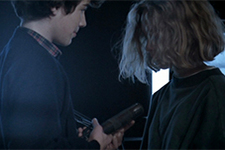Benny's Video
|  As Michael Haneke’s previous feature, The Seventh Continent (1989), ended with a television screen filled with static, his next feature, Benny’s Video, begins with it. As with so many of Haneke’s films, screens and communication technology play a major role in Benny’s Video narratively and thematically, but also visually, as their constant presence in the frame serves as a reminder of how technology can alienate, disassociate, and even ruin us. The screens in The Seventh Continent played primarily in the background as silent witness to an Austrian family’s shocking turn to mutual destruction, but here they are central to the titular character’s dangerous insulation from the world around him. Benny (Arno Frisch) is a teenager who lives in a large, high-rise condo in Vienna with his wealthy, but emotionally distant father (Ulrich Mühe) and his emotionally cowed mother (Angela Winkler). Benny’s room is crammed with video technology—computer monitors, television screens, editing bays, and cameras, one of which he ironically has pointed out the window that is otherwise draped in black cloth, thus unnecessarily channeling the outside world into a monitor. As far as we can tell, Benny does little but sit in his room and watch television and videos he has made, one of which documents the killing of a large sow with a bolt gun, which he watches (and, therefore, we do, too) over and over again, often in slow motion. The early scenes in the film have a familiar echo with The Seventh Continent, as Haneke dramatizes in mundane detail the routines of Benny and his family, none of which seem to bring any pleasure or human connection. One weekend Benny’s parents leave him alone for several days, during which time he meets a teenage girl (Ingrid Stassner) at the video shop he frequents and invites her back to his condo. Because we already sense that something is not right with Benny—his obsession with the pig-killing video, his physical and emotional isolation, the sullen manner in which he goes about his life—we are primed to expect the worst—which, of course, happens, but not until Haneke has dragged us through a long, awkward sequence of Benny trying and failing to have some kind of normal, meaningful interaction with this girl who seems to be just as disaffected and incapable of real communication as he is. Suffice it to say that something horrible and violent transpires, which begins as possibly an accident, but then escalates into something much worse, which Haneke shows us through the lens of one of Benny’s videocameras, rendering it both slightly removed and all the more horrific. For a filmmaker whose works are often and rightly described as violent, Haneke is a master of leaving the worst off-screen while making you feel it to your core anyway. The film’s second half involves Benny at first trying to cover up what he has done, after which he tells his parents by simply allowing them to watch the video of what transpired. They are rightly shocked, not just by what happened, but by Benny’s complacence in the aftermath, the true evidence of his sociopathy. But, what is even more shocking is how his parents react: the father, ever the rational, logical problem solver, recognizes that the revelation of what Benny has done will look bad on them, so they decide to cover it up for him. The mother takes Benny for a quick vacation in Egypt while the father stays beyond to dispose of the evidence. Thus, it becomes clear that Benny is not an aberration (which might offer some kind of emotional respite in a film that is otherwise virtually unbearable to watch and digest), but rather the logical product of people who view the world in purely transactional terms (the fact that Benny operates a pyramid scheme with kids at school is a not-so-subtle reminder of how the capitalist impulse at its most base is sociopathic). For the father, the depths of Benny’s transgression, however disturbing he may find them, are less important than maintaining his own livelihood and reputation, which suggests how social norms and conventions can so easily mask depravity of all sorts. As with so many of Haneke’s other films, Benny’s Video plays with a cool, clinical sense of detachment that makes its interpersonal and physical horrors resonate in ways that graphic violence and visual bombast simply couldn’t match. Already peerless in his ability to evoke the terrible depths to which people can sink and the resounding loss that comes with the breakdown of human connection, Haneke pushes the film constantly, holding on scenes and shots for uncomfortable periods of time and forcing us to reckon with life’s darker realities. Arno Frish, who would go on to play another young sociopath in Haneke’s Funny Games (1997), gives a disquieting performance that makes Benny both utterly loathsome and strangely pathetic. He does horrible things, yet you can’t help but feel that he is somehow the victim of his own inability to feel. His performance is of a boy who is already dead before he has the chance to become a man, which may be the most unnerving idea of all.
Copyright © 2023 James Kendrick Thoughts? E-mail James Kendrick All images copyright © The Criterion Collection | |||||||||||||||||||||||||||||
Overall Rating: 


 (3.5)
(3.5)


 Benny’s Video is available as part of Criterion’s three-disc set “Michael Haneke : Trilogy,” which also includes The Seventh Continent and 71 Fragments of a Chronicle of Chance.
Benny’s Video is available as part of Criterion’s three-disc set “Michael Haneke : Trilogy,” which also includes The Seventh Continent and 71 Fragments of a Chronicle of Chance.